Johann Heinrich Pestalozzi Johann Heinrich Pestalozzi (January 12,

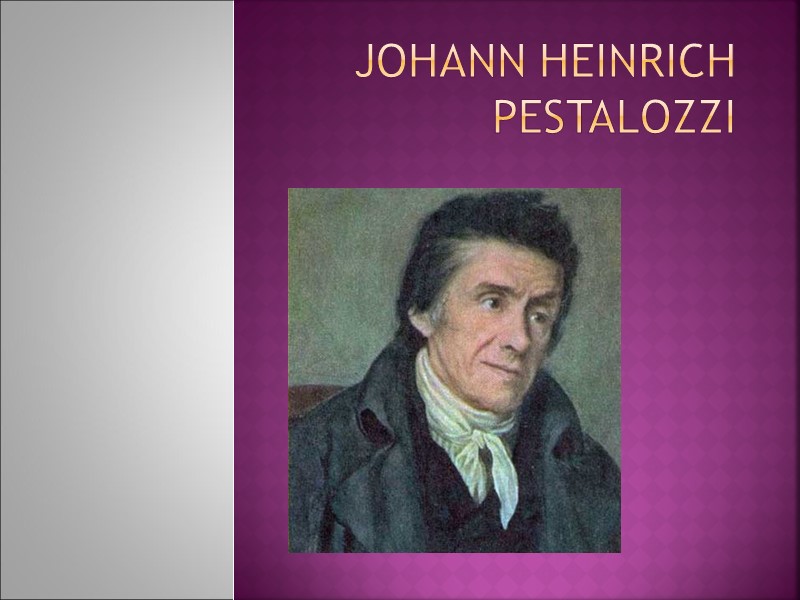





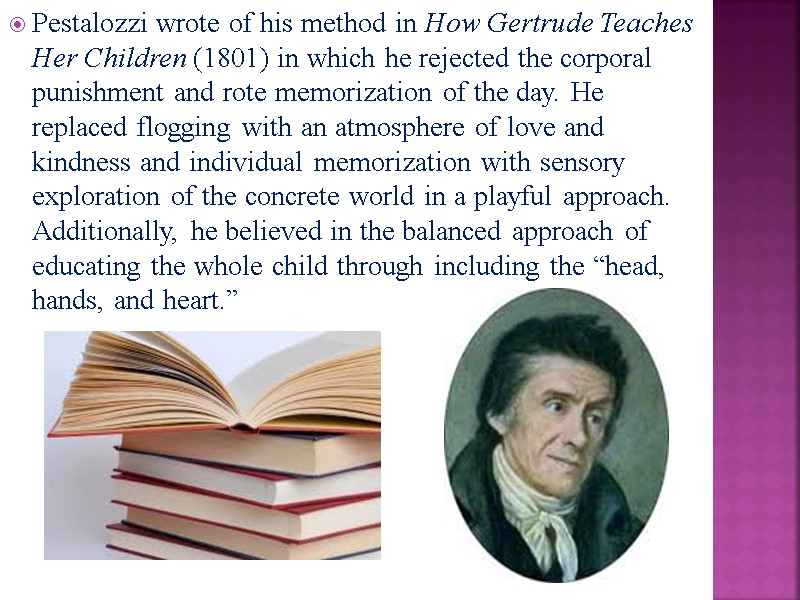
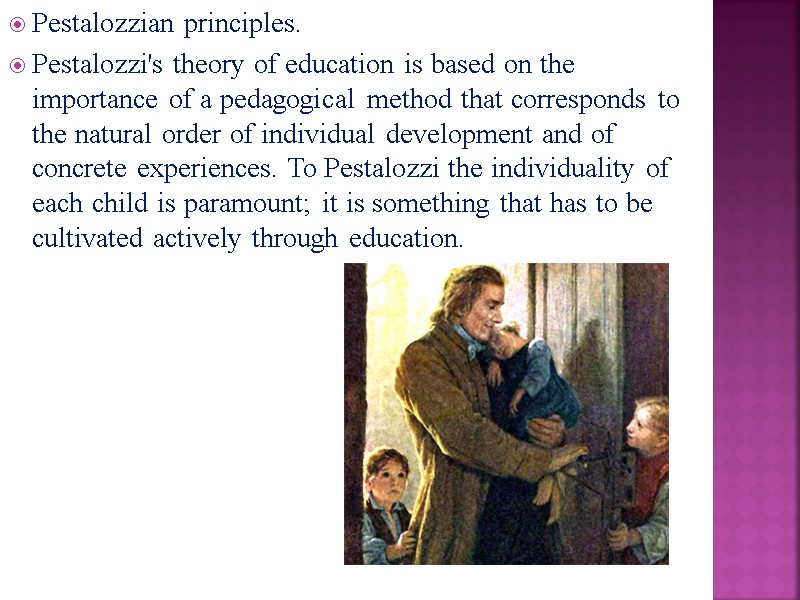
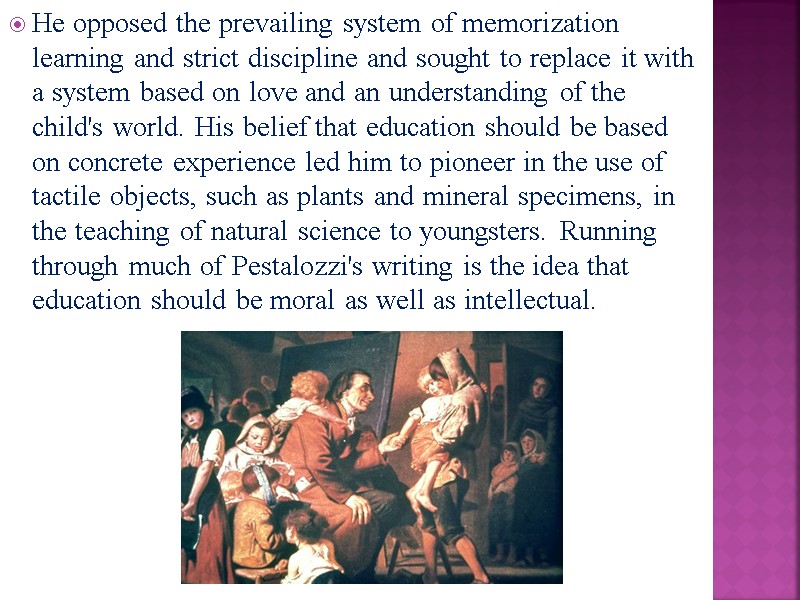

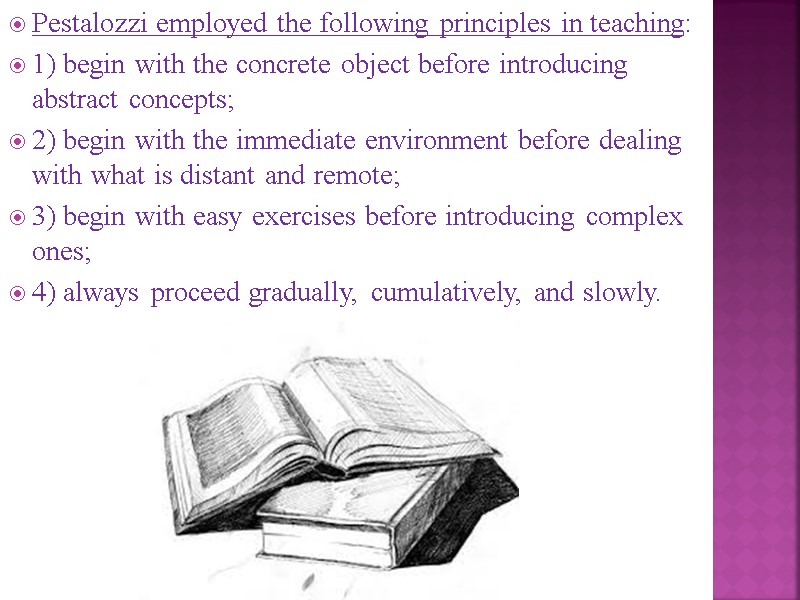
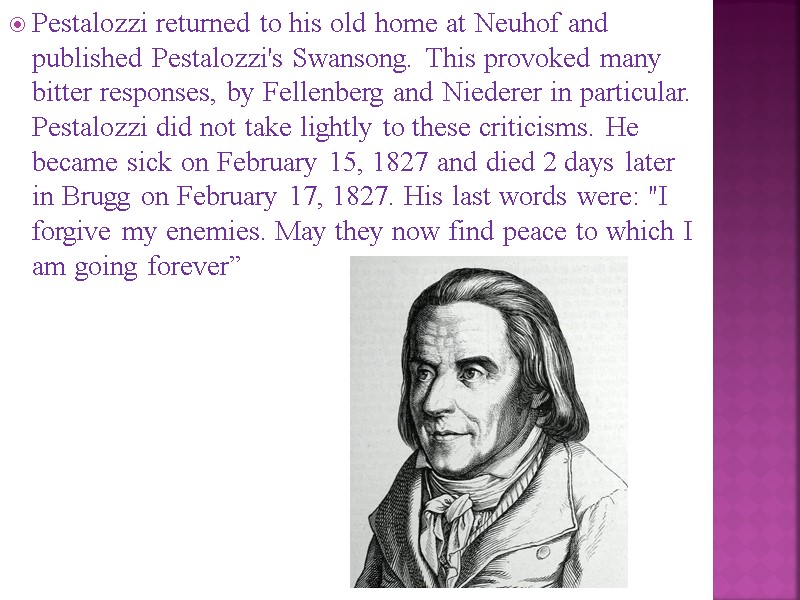
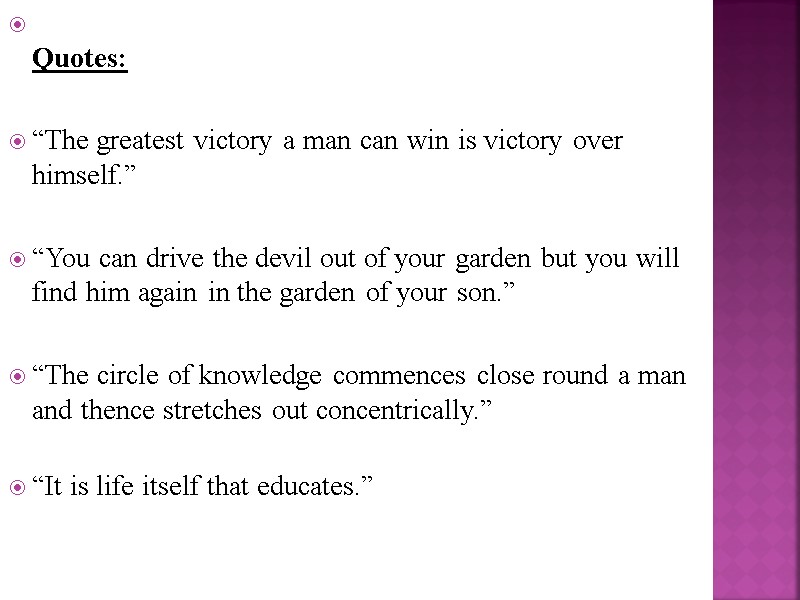

34562-johann_heinrich_pestalozzi.ppt
- Количество слайдов: 14
 Johann Heinrich Pestalozzi
Johann Heinrich Pestalozzi
 Johann Heinrich Pestalozzi (January 12, 1746 – February 17, 1827) was a Swiss pedagogue and educational reformer who exemplified Romanticism in his approach. Pestalozzi was born on January 12, 1746, in Zürich, Switzerland. His father was a surgeon and oculistt who died at age 33 when Pestalozzi, the second of three children, was 6 years old. His mother, whose maiden name was Hotze, was a native of Wädenswill on the lake of Zürich. The family also had a maid, Barbara Schmid, nicknamed Babeli. After the death of Pestalozzi's father it was only through the help of Babeli that Pestalozzi's mother could financially support the family.
Johann Heinrich Pestalozzi (January 12, 1746 – February 17, 1827) was a Swiss pedagogue and educational reformer who exemplified Romanticism in his approach. Pestalozzi was born on January 12, 1746, in Zürich, Switzerland. His father was a surgeon and oculistt who died at age 33 when Pestalozzi, the second of three children, was 6 years old. His mother, whose maiden name was Hotze, was a native of Wädenswill on the lake of Zürich. The family also had a maid, Barbara Schmid, nicknamed Babeli. After the death of Pestalozzi's father it was only through the help of Babeli that Pestalozzi's mother could financially support the family.
 In 1751, Pestalozzi attended the Gymnasium (Collegium Humanitatis) and received instruction from educators Johann Jakob Bodmer and Johann Jakob Breitinger who taught history & politics and Greek & Hewrew, respectively. Pestalozzi was educated to become a clergyman. As a clergyman, he expected to have ample opportunity to carry out his educational ideas; however, the failure of his first sermon and influence from philosopher Jean-Jacques Rousseau led him to pursue a career in law and political justice.
In 1751, Pestalozzi attended the Gymnasium (Collegium Humanitatis) and received instruction from educators Johann Jakob Bodmer and Johann Jakob Breitinger who taught history & politics and Greek & Hewrew, respectively. Pestalozzi was educated to become a clergyman. As a clergyman, he expected to have ample opportunity to carry out his educational ideas; however, the failure of his first sermon and influence from philosopher Jean-Jacques Rousseau led him to pursue a career in law and political justice.
 Ideas: Pestalozzi was a Romantic who felt that education must be broken down to its elements in order to have a complete understanding of it. Pestalozzi's educational methods were child-centered and based on individual differences, sense perception, and the student's self-activity. Pestalozzi worked in Yverdon to 'elementarize' the teaching of ancient languages, principally Latin, but also Hebrew and Greek.
Ideas: Pestalozzi was a Romantic who felt that education must be broken down to its elements in order to have a complete understanding of it. Pestalozzi's educational methods were child-centered and based on individual differences, sense perception, and the student's self-activity. Pestalozzi worked in Yverdon to 'elementarize' the teaching of ancient languages, principally Latin, but also Hebrew and Greek.
 In 1819, Stephan Ludwig Roth came to study with Pestalozzi, and his new humanism contributed to the development of the method of language teaching, including considerations such as the function of the mother tongue in the teaching of ancient languages. Pestalozzi and Niederer were important influences on the theory of physical education; they developed a regimen of physical exercise and outdoor activity linked to general, moral, and intellectual education that reflected Pestalozzi's ideal of harmony and human autonomy.
In 1819, Stephan Ludwig Roth came to study with Pestalozzi, and his new humanism contributed to the development of the method of language teaching, including considerations such as the function of the mother tongue in the teaching of ancient languages. Pestalozzi and Niederer were important influences on the theory of physical education; they developed a regimen of physical exercise and outdoor activity linked to general, moral, and intellectual education that reflected Pestalozzi's ideal of harmony and human autonomy.
 Pestalozzi's philosophy of education was based on a four-sphere concept of life and the premise that human nature was essentially good. The first three 'exterior' spheres - home and family, vocational and individual self-determination, and state and nation - recognized the family, the utility of individuality, and the applicability of the parent-child relationship to society as a whole in the development of a child's character, attitude toward learning, and sense of duty. The last 'exterior' sphere - inner sense - posited that education, having provided a means of satisfying one's basic needs, results in inner peace and a keen belief in God.
Pestalozzi's philosophy of education was based on a four-sphere concept of life and the premise that human nature was essentially good. The first three 'exterior' spheres - home and family, vocational and individual self-determination, and state and nation - recognized the family, the utility of individuality, and the applicability of the parent-child relationship to society as a whole in the development of a child's character, attitude toward learning, and sense of duty. The last 'exterior' sphere - inner sense - posited that education, having provided a means of satisfying one's basic needs, results in inner peace and a keen belief in God.
 Pestalozzi wrote of his method in How Gertrude Teaches Her Children (1801) in which he rejected the corporal punishment and rote memorization of the day. He replaced flogging with an atmosphere of love and kindness and individual memorization with sensory exploration of the concrete world in a playful approach. Additionally, he believed in the balanced approach of educating the whole child through including the “head, hands, and heart.”
Pestalozzi wrote of his method in How Gertrude Teaches Her Children (1801) in which he rejected the corporal punishment and rote memorization of the day. He replaced flogging with an atmosphere of love and kindness and individual memorization with sensory exploration of the concrete world in a playful approach. Additionally, he believed in the balanced approach of educating the whole child through including the “head, hands, and heart.”
 Pestalozzian principles. Pestalozzi's theory of education is based on the importance of a pedagogical method that corresponds to the natural order of individual development and of concrete experiences. To Pestalozzi the individuality of each child is paramount; it is something that has to be cultivated actively through education.
Pestalozzian principles. Pestalozzi's theory of education is based on the importance of a pedagogical method that corresponds to the natural order of individual development and of concrete experiences. To Pestalozzi the individuality of each child is paramount; it is something that has to be cultivated actively through education.
 He opposed the prevailing system of memorization learning and strict discipline and sought to replace it with a system based on love and an understanding of the child's world. His belief that education should be based on concrete experience led him to pioneer in the use of tactile objects, such as plants and mineral specimens, in the teaching of natural science to youngsters. Running through much of Pestalozzi's writing is the idea that education should be moral as well as intellectual.
He opposed the prevailing system of memorization learning and strict discipline and sought to replace it with a system based on love and an understanding of the child's world. His belief that education should be based on concrete experience led him to pioneer in the use of tactile objects, such as plants and mineral specimens, in the teaching of natural science to youngsters. Running through much of Pestalozzi's writing is the idea that education should be moral as well as intellectual.
 Never losing his commitment to social reform, Pestalozzi often reiterated the belief that society could be changed by education. His theories also influenced the development of teacher-training methods. Although he respected the individuality of the teacher, Pestalozzi nevertheless felt that there was a unified science of education that could be learned and practiced. His belief that teacher training should consist of a broad liberal education followed by a period of research and professional training has been widely adopted throughout Europe and the United States.
Never losing his commitment to social reform, Pestalozzi often reiterated the belief that society could be changed by education. His theories also influenced the development of teacher-training methods. Although he respected the individuality of the teacher, Pestalozzi nevertheless felt that there was a unified science of education that could be learned and practiced. His belief that teacher training should consist of a broad liberal education followed by a period of research and professional training has been widely adopted throughout Europe and the United States.
 Pestalozzi employed the following principles in teaching: 1) begin with the concrete object before introducing abstract concepts; 2) begin with the immediate environment before dealing with what is distant and remote; 3) begin with easy exercises before introducing complex ones; 4) always proceed gradually, cumulatively, and slowly.
Pestalozzi employed the following principles in teaching: 1) begin with the concrete object before introducing abstract concepts; 2) begin with the immediate environment before dealing with what is distant and remote; 3) begin with easy exercises before introducing complex ones; 4) always proceed gradually, cumulatively, and slowly.
 Pestalozzi returned to his old home at Neuhof and published Pestalozzi's Swansong. This provoked many bitter responses, by Fellenberg and Niederer in particular. Pestalozzi did not take lightly to these criticisms. He became sick on February 15, 1827 and died 2 days later in Brugg on February 17, 1827. His last words were: "I forgive my enemies. May they now find peace to which I am going forever”
Pestalozzi returned to his old home at Neuhof and published Pestalozzi's Swansong. This provoked many bitter responses, by Fellenberg and Niederer in particular. Pestalozzi did not take lightly to these criticisms. He became sick on February 15, 1827 and died 2 days later in Brugg on February 17, 1827. His last words were: "I forgive my enemies. May they now find peace to which I am going forever”
 Quotes: “The greatest victory a man can win is victory over himself.” “You can drive the devil out of your garden but you will find him again in the garden of your son.” “The circle of knowledge commences close round a man and thence stretches out concentrically.” “It is life itself that educates.”
Quotes: “The greatest victory a man can win is victory over himself.” “You can drive the devil out of your garden but you will find him again in the garden of your son.” “The circle of knowledge commences close round a man and thence stretches out concentrically.” “It is life itself that educates.”
 THANK YOU FOR YOUR ATTENTION!!!!!
THANK YOU FOR YOUR ATTENTION!!!!!

